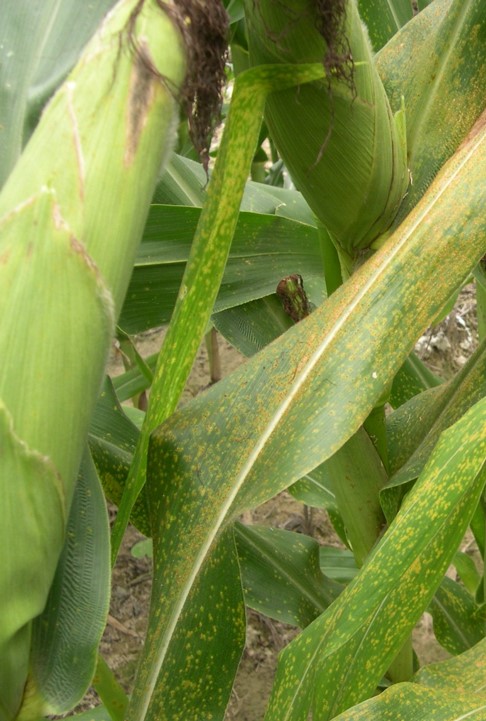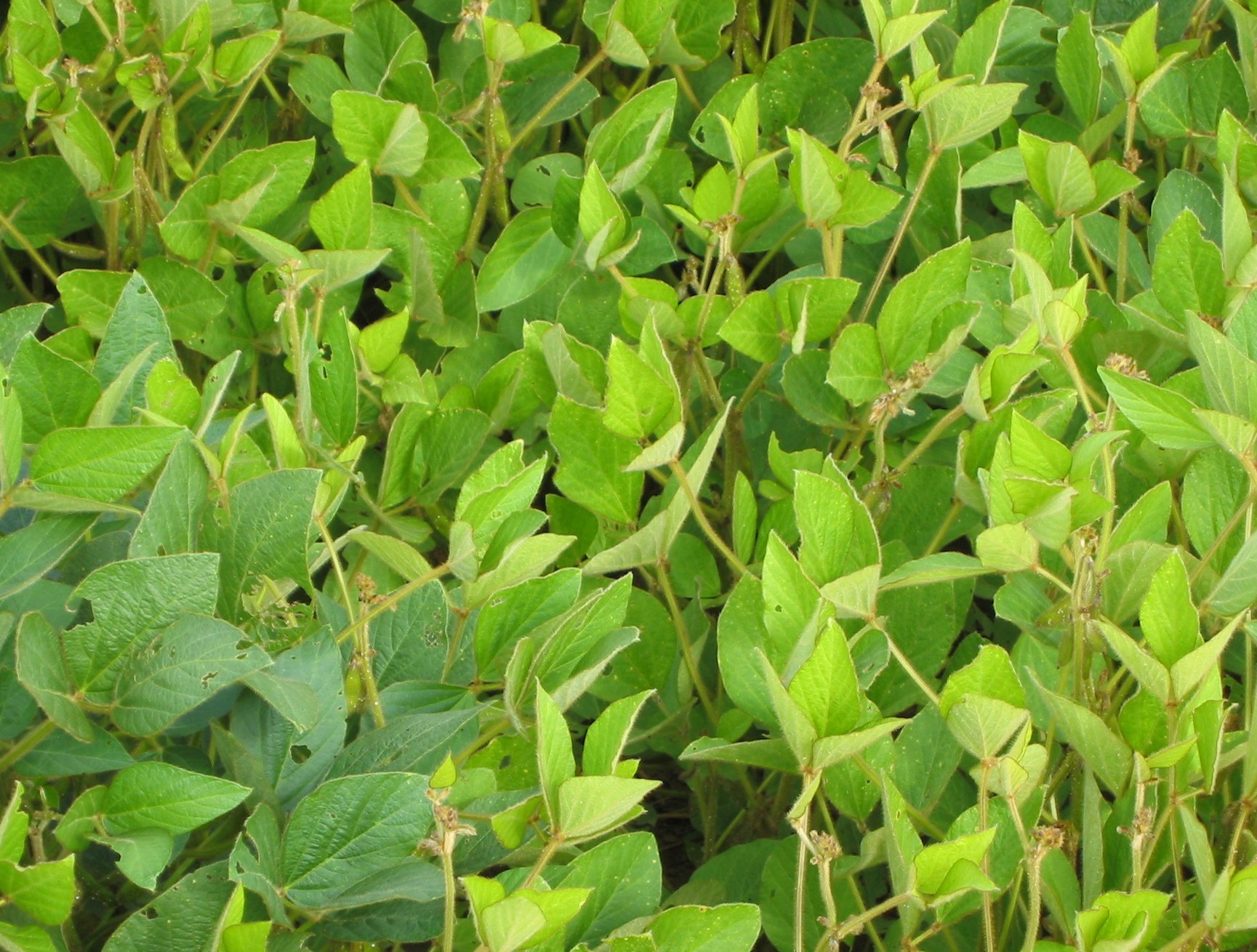I have recently seen several peanut fields or spots in the fields around the Tidewater AREC with yellow plants resembling nitrogen deficiency. Colleagues in North Carolina are also getting concerned with peanuts needing late season nitrogen applications. Similarly, in one of my research fields we noticed a part of the field with yellow plants resembling nitrogen deficiency next to dark green plants for the rest of the area. Indeed, early this summer Kelvin Wells, Extension Agent in Sussex county VA, brought in some samples of yellow peanut plants. Right away I identified nitrogen deficiency because there were no nodules on the roots and plants were starting blooming; also the farmer did not inoculate at planting. It was easy. But with the plants from my own field trial it is not so easy! Yellow and smaller plants had larger nodules than the bigger and greener plants and in a similar number on July 17 when I checked. Nodules from both plants, green and yellow, were dark red when cut, indicating active nitrogen fixation (pictures are attached here Unusual peanut color). The green plants were planted on May 10 and the yellow ones on May 22. I really do not have any other explanation than probable negative effect of high temperatures and dry conditions experienced by late planted peanuts in Virginia this year. This could have affected root growth and nodulation for young seedlings and carried nutritional imbalances over to later stages.
Category Archives: Commodity
Corn disease update – July 26, 2015
Much of the field corn in the region is near or at the dent stage and no longer at risk for yield loss from foliar diseases. One disease I frequently receive questions about is southern corn rust. Southern corn rust is a potentially aggressive disease, but the fungus does not overwinter in Virginia and it is typically seen late in the growing season if at all. In 2014, southern corn rust was confirmed in Virginia on August 3, which is relatively early compared to other years. As of this week, southern corn rust has been confirmed from four North Carolina counties (Hyde, Lenior, Beaufort, and Camden) but it has not been observed in Virginia. We very well may see southern corn rust in southeastern Virginia within the next couple of weeks, but there is no need to panic. Yield of corn at or near the dent stage is unlikely to be impacted by the disease, but late planted corn in fields with good yield potential (120 bu/ac +) may need to be protected with a foliar fungicide. Strobilurins are good preventative fungicides whereas triazoles are recommended once sporulation is observed in a field due to their curative activity. A combination fungicide is a good option as long as a strobilurin fungicide has not been applied previously. Wet, warm weather favors disease development. Once sporulation occurs, symptoms of rust are relatively obvious. Lesions start out as raised, blister-like pustules then break open to reveal orange spores. Samples of corn plants with symptoms of southern rust can be submitted to the disease clinic at the Virginia Tech Tidewater AREC (contact Dr. Hillary Mehl, hlmehl@vt.edu).
July 23, 2015 update for brown marmorated stink bug and kudzu bug survey of soybean
In soybean, our scouts have detected BMSB in Bedford, and kudzu bug in Brunswick, Campbell, Cumberland, Dinwiddie, Greensville, Nottoway, Prince Edward, Suffolk, and Surry. Kudzu bug has been observed on other hosts (i.e., kudzu) in Appomattox, Buckingham, Isle of Wight, and Southampton. Please see the attached maps for further details. BMSB_KB_23_Jul_2015
Black light trap captures for the week ending July 23, 2015
Corn earworm moth captures were low this week, ranging from zero to 0.7 per night. BMSB catches ranged from zero to 2 per night. Please see the attached file for the data tables. Thanks to the following for their reports this week: Mary Beahm (Warsaw), Scott Reiter (Prince George), David Moore and intern Taylor Sabo (Middlesex), Austin Brown (Southampton), and Dr. Herbert and the entomology crew in Suffolk. BLT_23_Jul_2015
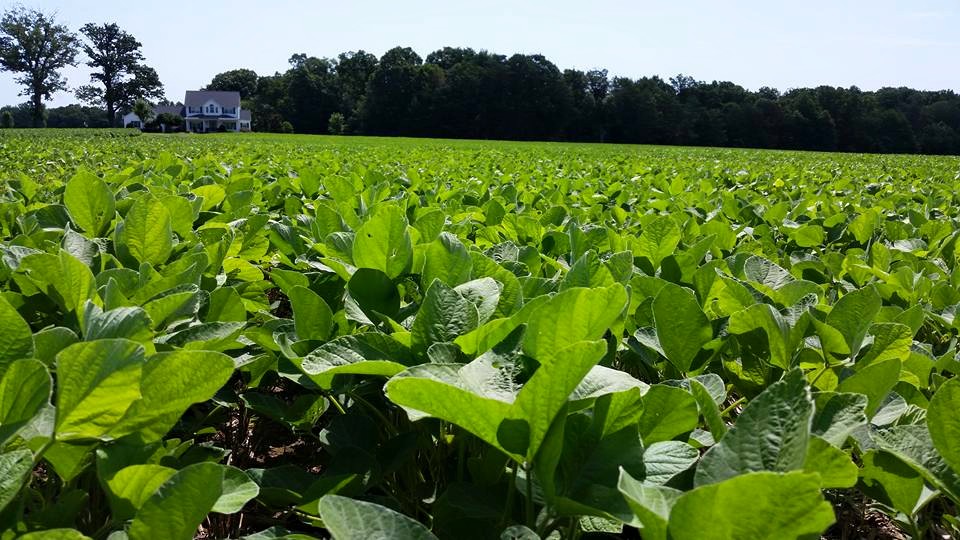
Should I Apply a Foliar Feed to My Soybeans?
The high prices over the last few years have allowed many of us to experiment with certain practices that, at best, might occasionally increase yields. The return of investment usually only required one bushel (or less), depending on the input. But that was when soybeans were $13, $15, and even $17 per bushel. But now, you may be able to sell your crop for $10-11 (if you still have any in storage) and the future prices are reflecting record acreages.
So, it seems that I’ve been asked, “Should I apply a foliar feed to my soybeans?” more this year than in the past few years.
First, I still stand by what I’ve said in the past and still say today: “Feed the roots and not the foliage.” Soybean will remove 3 to 4 lbs of nitrogen, 0.8 lbs of phosphorus, and 1.4 lbs of potassium per bushel of seed produced. These large amounts will need to come via root uptake; it is not economically possible to apply these amounts through the foliage.
But, once the soil needs are met, will additional fertilization help?
First, an application of Manganese may be needed if your soil pH inches much above 6.5. 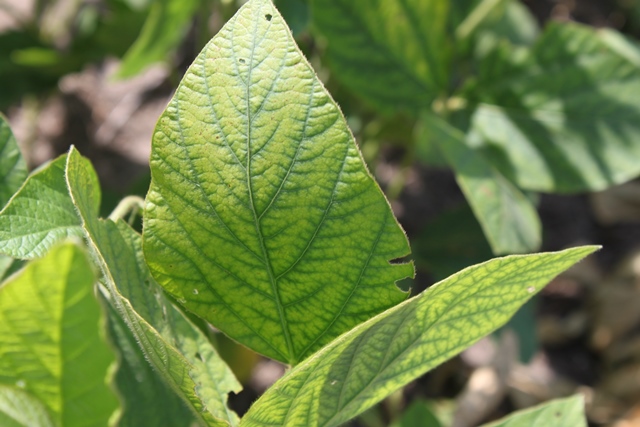 I’ve even seen Mn deficiencies when the pH is as low as 6.2 (using fall/winter soil test levels) and the soil is “wet natured” or if lime was recently applied. There are also certain varieties that tend to show Mn deficiency sooner than others. So, if you see the characteristic interveinal chlorosis of Mn deficiency or if soybean are growing in a field that typically exhibits such a deficiency, then spray Mn.
I’ve even seen Mn deficiencies when the pH is as low as 6.2 (using fall/winter soil test levels) and the soil is “wet natured” or if lime was recently applied. There are also certain varieties that tend to show Mn deficiency sooner than others. So, if you see the characteristic interveinal chlorosis of Mn deficiency or if soybean are growing in a field that typically exhibits such a deficiency, then spray Mn.
Another issue that I’m seeing this year is a general yellowing of plants, usually just in seemingly random spots in the field. Upon closer inspection, these are usually very wet areas (there are plenty of those this year) or sandy knolls. In the saturated soils, the yellowing is likely due to lack of oxygen and/or poor nodule development. The only cure for lack of oxygen is for the soil to dry out. Poor nodulation is indirectly a response to lack of oxygen – the nitrogen-fixing bacteria have temporarily stopped functioning. But they will recover and provide the nitrogen when the plant needs it the most, when the pods are forming and seed are filling. Will a shot of foliar nitrogen help? Yes, it will green up the plant if lack of nitrogen is the problem. Will this shot of nitrogen (assuming that nitrogen is the problem) increase yield? Maybe. Maybe not. If lack of oxygen is the problem, then probably not. Even if lack of nitrogen is the problem, probably not.
I want to caution everyone to not make assumptions that lack of nitrogen is the problem.
The only way to know for sure is to take a tissue sample. A deficiency that closely resembles nitrogen deficiency is sulfur. On those sandy knolls, I’ve seen sulfur deficiencies. Sulfur will leach just like nitrogen. But, soybean will not produce its own sulfur. A shot of nitrogen would do nothing to help in this case. The take home message is to determine the cause, then act on that information.
But what about other nutrients? What if there is no visual symptoms of nutrient stress? What if my yield potential is very good? My attitude towards this is that it usually won’t hurt (but be careful mixing with other chemicals), so do what makes you sleep better at night. If you think it is helping your crop, then make the application. It’s your money. You know your fields better than anyone. But, I have rarely seen a response to foliar feeds if you have maintained adequate soil fertility levels and have managed the crop for maximum economic yields. Again, yield response to foliar fertilizers is, at best, inconsistent.
Kudzu bug distribution update for July 16, 2015
Our scouts (Ed Seymore, Jamie Hogue, and Dr. Herbert’s Entomology team) have started sampling soybean fields across Virginia for kudzu bug and brown marmorated stink bug. The file attached at the end of this paragraph indicates the counties where kudzu bug has been found (blue counties = kudzu bug found in soybean; maroon counties = kudzu bug found on other hosts such as kudzu). Please note that we have not yet sampled all counties on our survey route. I will continue to provide weekly updates on this, including pest population levels, as the season progresses. KB_7_16_2015
Black light trap captures for the week ending July 16, 2015
Corn earworm moth catches from reporting stations were low this week. Nightly averages were: Warsaw=zero; Southampton (Courtland)=zero; Suffolk=0.4. Brown marmorated stink bug nightly averages were: Warsaw=zero; Southampton (Courtland)=1.3; Suffolk=zero. Thanks to the following for their reports this week: Mary Beahm, Austin Brown, and Dr. Herbert’s Entomology team. The image of the “bucket style” black light trap is courtesy of Austin Brown. 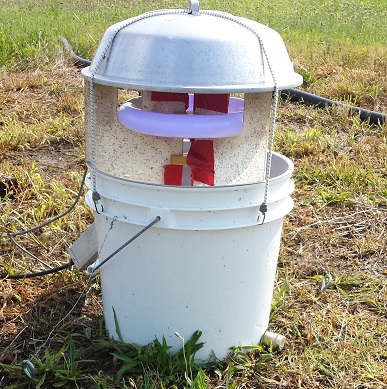
Monitoring Nitrogen Status of Cotton during Bloom in Virginia
The following advisory is from Dr. Hunter Frame: Tissue Testing During Bloom in Virginia Cotton
Fungicide Resistant Frogeye Leaf Spot Present in Virginia
Fungicides are an important and effective tool for management of fungal diseases of crops including soybean. Unfortunately, over time fungal pathogens have the potential to develop resistance to specific fungicide modes-of-action. Mutations conferring resistance to fungicides are relatively rare, but multiple applications of the same fungicide chemistry impose selection pressure on pathogen populations and increase the frequency of those mutations over relatively short periods of time. Thus, specific fungicide chemistries have the potential to lose their effectiveness over time. Fungicide resistant isolates of Cercospora sojina, the causal agent of frogeye leaf spot in soybean, have recently been confirmed throughout the southeast including in North Carolina in 2013 and Virginia in 2014. In 2014, a small preliminary survey was conducted to determine if fungicide resistance is occurring in Virginia populations of frogeye leaf spot. Four fields were tested, and two of those fields had fungicide resistant strains. The resistance is specific to strobilurin (QoI, FRAC group 11) fungicides, which are highly effective for control of fungal foliar diseases but to which resistance can rapidly occur within fungal populations. Effective foliar disease management requires appropriate fungicide chemistry selection based on the specific pathogens present and their sensitivity to different fungicide modes of action.
Additional isolates of the frogeye leaf spot pathogen from throughout Virginia need to be collected and tested for fungicide resistance so that appropriate fungicide recommendations can be made. Other states have already initiated fungicide resistance monitoring programs for the causal agent of frogeye leaf spot (C. sojina), and we will implement a similar program in Virginia. Soybean leaves with symptoms of frogeye leaf spot will be collected throughout the 2015 growing season, the fungus will be isolated, and isolates will be tested for resistance to strobilurin (QoI) fungicides. If fungicide resistance is widespread in Virginia, recommendations for foliar fungicides and/or cultivar selection may need to be modified. If incidence of fungicide resistance is low, we will continue to monitor fungal populations and assess the risk of fungicide control failures on a year-by-year basis.
In order to implement an effective fungicide resistance monitoring program, we are requesting that leaf samples from soybean fields with symptoms of frogeye leaf spot (see pictures above) be submitted to the Tidewater AREC for testing. For more information on submitting samples, please contact Dr. Hillary Mehl (757) 657-6450 ext. 423 or hlmehl@vt.edu.
Black light trap report for the week ending July 9, 2015
This week, corn earworm moth captures in black light traps were zero at Warsaw, Suffolk, and Southampton. Brown marmorated stink bug catches (nightly averages) were 0.1 for Warsaw, zero for Suffolk, and 0.3 for Southampton. Thanks to Mary Beahm, Ames Herbert and crew, and Austin Brown for their reports this week.

